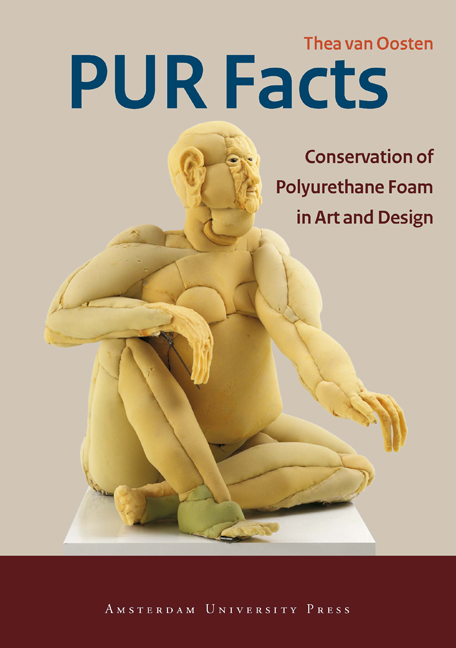Book contents
- Frontmatter
- Contents
- Preface
- Introduction
- 1 Polyurethanes, Manufacture and Applications
- 2 Chemistry, Properties and Degradation
- 3 History of Polyurethane foam Conservation
- 4 Ageing Behaviour of Polyurethane foam
- 5 Assessing the Condition of Polyurethane foam
- 6 Case Studies
- Acknowledgements
- Glossary
- General Information
- Bibliography
- Frontmatter
- Contents
- Preface
- Introduction
- 1 Polyurethanes, Manufacture and Applications
- 2 Chemistry, Properties and Degradation
- 3 History of Polyurethane foam Conservation
- 4 Ageing Behaviour of Polyurethane foam
- 5 Assessing the Condition of Polyurethane foam
- 6 Case Studies
- Acknowledgements
- Glossary
- General Information
- Bibliography
Summary
In 1969 scientist Paul F. Bruins wrote the following in the preface to the book Polyurethane Technology:
“Polyurethane technology is both a science and an art. Remarkable advances have been made in the past few years in both areas, thus creating the need for a review of the present state of knowledge and a projection into future developments.”
During my research into the conservation of plastics, particularly polyurethanes, I observed that 40 years later, they are even more widely used in science and art than when the above was written. Polyurethanes with tailor-made properties have been developed, and numerous applications for this material and works of art have been created. This has brought with it new challenges for the conservation of these ‘new materials’, such as the consolidation of polyurethane foams in works of art.
The main motivation behind this book PUR Facts was to describe the conservation and consolidation treatment of endangered polyurethane ether foams, especially those used in cultural heritage objects. To place polyurethane ether foam in its proper context, however, the book also deals with its history, manufacture and applications and gives examples of works of art and design objects made of other polyurethanes. PUR Facts is a semi-technical publication presenting a brief overview of the field of polyurethane production without going into too many technical details. It seeks to demonstrate general principles so that readers not so well versed in chemistry can obtain an understanding of the versatility and potential of polyurethanes.
Although I wanted to keep this book accessible to non-scientists, there are some parts that delve a little deeper into the chemistry of polyurethanes, as this is needed for a fuller understanding.
Hence this book is aimed not only at conservators and conservation scientists but also at curators and keepers of collections, art collectors and artists and designers who wish to know something about fields of expertise other than their own.
Chapter 1 describes the production and use of flexible polyurethane foams in daily life and in objects of cultural heritage. Ever since polyurethane foam first became available, artists and designers have had a great appreciation for this ‘new’ material. Forty years later, we see ourselves confronted with the limited durability of the early polyurethane foams: loss of flexibility, cracking, crumbling and powdering of the foam.
- Type
- Chapter
- Information
- PUR FactsConservation of Polyurethane Foam in Art and Design, pp. 9 - 12Publisher: Amsterdam University PressPrint publication year: 2011



